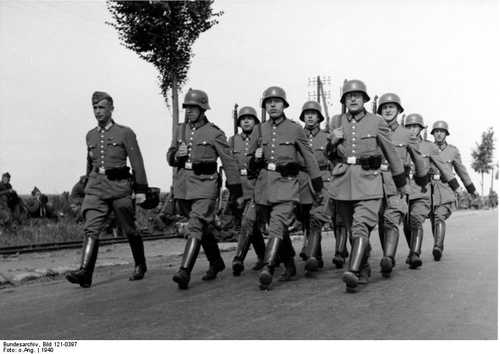
German Forces
A Policeman's lot ...
Bundesarchiv.
... for these policemen, marching into France, 1940. The German police went through two revolutions under the Nazis. The first was organizational - the abandonment of the system based on the local states and consolidation of control of the police services (or most of control, anyway) under two national head offices, one for the Security Police formations, and one for the "Ordinary Police". The latter - the Ordnungspolizei" (Order Police) was divided into a number of service branches. The principal of these was the Schutzpolizei (responsible for policing in the cities and major towns) and the Gendarmerie (responsible for policing lesser urban centres and the countryside). The second shake-up related to personnel, and came at the onset of war. The Ordnungspolizei - the Schutzpolizei in particular - were allowed to develop into something akin to yet another Nazi private army, in part, to compensate Orpo commander Kurt Daluege for his failure to be appointed head of the more "exciting" (and powerful) Security Police bureau. Since service in the Orpo involved an exemption from military service when conscription was re-introduced, it was viewed by some as something of a shirker's charter. This position was no longer tenable when war arrived. A new arrangement between the Nazi leaders saw many of the best-quality Schutzpolizei transferred into military formations - the (future SS) Polizei Division, and other Police combat formations (without more than the mere formality of volunteering). Many more - of "second" or "third" quality, found themselves in Special Police Security units of various designations, who would provide the German element of "ordinary" policing in occupied territory. These formations, at least initially, remained "police" formations; however, the Polizei Division in particular (like the Waffen-SS) were placed at the operational discretion of the Wehrmacht for the duration of the war. The fine body of men pictured here (with the possible exception of the slightly portly "Captain Mainwaring" figure first rank, right) are a well turned-out group, probably members of a Polizei Security Battalion. In France, they would have carried out general policing and security duties in conjunction with the French Police and Gendarmerie formations. There was a darker side to their functions, however. Since they remained policemen, both they and their local colleagues were at the primary disposal of local SS and Police Leaders. They thus became a (actually the) primary source of manpower for "special actions" of various sorts, decreed by such Leaders. In France, where the Heer maintained a large number of "static" occupation formations, this activity remained, to a relatively large extent, pretty conventional. In the East, on the other hand, Police security units along with local police formations were to provide the bulk of the "muscle" required to effect such actions as the elimination of the rural Jews of Poland and, further east, the actions of the Einsatzgruppen in captured Soviet territory. Towards the end of the war, the distinction between Polizei security units and Polizei combat units became distinctly blurred, and many Schupo men found themselves in the front line against the Allies, east and west, a role for which they were generally ill-prepared. Oh well. At least they were somewhat better trained than the average Volksgrenadier ... Best regards, JR.
3065 Views
12/18/2014
